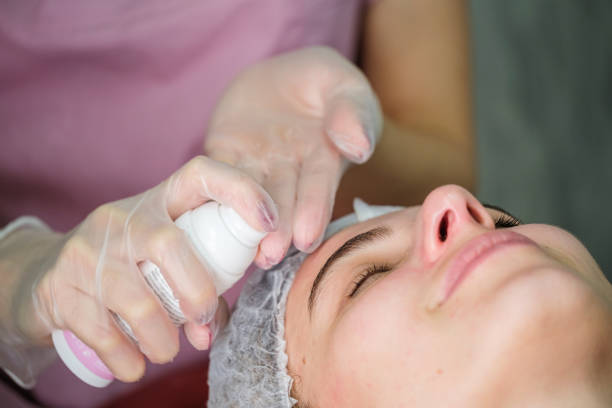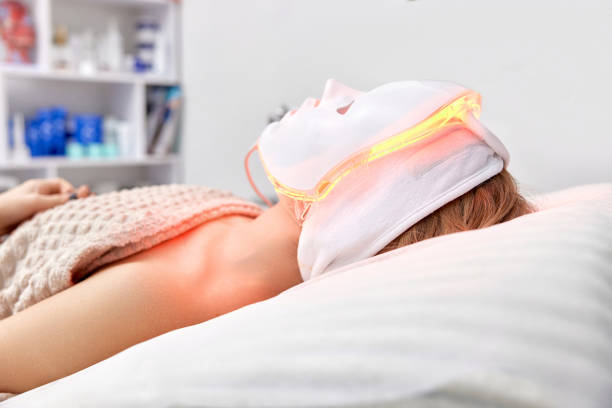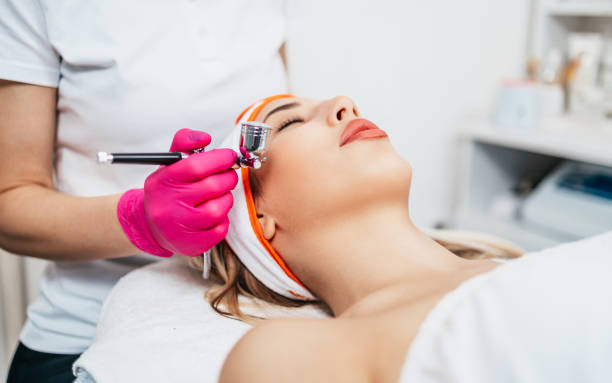

Superficial chemical peels are a popular choice for individuals looking to refresh and rejuvenate their skin. These types of peels are typically mild in nature, making them suitable for those who are new to chemical exfoliation or have sensitive skin.
One of the key benefits of superficial chemical peels is that they can help improve the appearance of fine lines, wrinkles, acne scars, and hyperpigmentation. By gently removing the top layer of dead skin cells, these peels can reveal smoother, more radiant skin underneath.
In addition to their cosmetic benefits, superficial chemical peels can also help improve the overall health and texture of the skin. By stimulating collagen production and promoting cell turnover, these peels can leave your complexion looking brighter and more youthful.
When considering a superficial chemical peel, it's important to consult with a skincare professional to determine the best option for your specific needs. They will be able to assess your skin type and concerns and recommend a treatment plan that will deliver optimal results.
Overall, superficial chemical peels are a safe and effective way to achieve healthier, more radiant skin. Whether you're looking to address signs of aging or simply want to maintain a glowing complexion, these peels can help you achieve your skincare goals.
Medium-depth chemical peels are a popular choice among individuals looking to improve the appearance of their skin. These peels offer more intense results compared to superficial peels, but are less aggressive than deep peels.
During a medium-depth chemical peel, a solution containing ingredients such as trichloroacetic acid (TCA) is applied to the skin to remove damaged outer layers and stimulate collagen production. This can help reduce the appearance of fine lines, wrinkles, sun damage, acne scars, and uneven pigmentation.
While medium-depth chemical peels can provide noticeable improvements in skin texture and tone, they do require some downtime for recovery. Patients may experience redness, swelling, and peeling of the skin for several days following the procedure. It is important to follow post-peel care instructions provided by your skincare professional to ensure optimal results and minimize potential side effects.
Overall, medium-depth chemical peels are a great option for individuals seeking more dramatic results without undergoing a surgical procedure. With proper preparation and aftercare, these peels can help rejuvenate the skin and enhance its overall appearance.
If you're considering getting a chemical peel near Frisco, you may be wondering about the benefits of this popular skincare treatment.. Chemical peels offer a wide range of advantages that can help improve the overall health and appearance of your skin.
One of the main benefits of getting a chemical peel is that it can effectively exfoliate the outer layers of your skin, removing dead skin cells and revealing smoother, more radiant skin underneath.

Posted by on 2024-05-22
Are you curious about chemical peels and what they can do for your skin?. If so, you're in luck!

Posted by on 2024-05-22
Chemical peels are a popular cosmetic treatment offered at many spas near Frisco.. These peels can help improve the appearance of the skin by removing dead skin cells and stimulating cell turnover.

Posted by on 2024-05-22
Deep chemical peels are a type of skin treatment that goes beyond the surface layers to target deeper imperfections and signs of aging. These peels contain stronger acids, such as trichloroacetic acid (TCA) or phenol, which penetrate more deeply into the skin to provide dramatic results.
Unlike superficial or medium-depth peels, deep chemical peels require more downtime for recovery as they can cause significant redness, swelling, and peeling. However, the results are often worth it for those looking to address deep wrinkles, sun damage, acne scars, or uneven pigmentation.
It's important to consult with a qualified dermatologist or skincare professional before undergoing a deep chemical peel to ensure it is the right treatment for your specific concerns and skin type. They can also provide guidance on how to properly care for your skin post-peel to maximize results and minimize potential side effects.
Overall, deep chemical peels can be an effective option for those seeking more intensive skin rejuvenation and are willing to commit to the necessary recovery time.
Combination chemical peels are a popular choice for individuals seeking to rejuvenate their skin and address multiple concerns at once. These peels combine different types of acids, such as glycolic acid, salicylic acid, and lactic acid, to target various skin issues like acne, hyperpigmentation, fine lines, and uneven texture.
By utilizing a combination of acids, these peels can provide more comprehensive results compared to single-acid peels. For example, glycolic acid helps exfoliate the outer layer of the skin, while salicylic acid penetrates deeper into the pores to unclog them and reduce acne. Lactic acid helps hydrate and brighten the skin, making it look more radiant and youthful.
One of the benefits of combination chemical peels is that they can be customized to suit individual skin types and concerns. A skincare professional can adjust the concentrations of each acid based on the client's needs and tolerance levels. This personalized approach ensures that the peel is effective yet gentle on the skin.
It is important to note that combination chemical peels may require some downtime for recovery as they can cause redness, flaking, and sensitivity. However, many clients find that the results are well worth it as their skin looks clearer, smoother, and more even-toned after treatment.
Overall, combination chemical peels are a versatile option for those looking to improve their skin's appearance and address multiple issues simultaneously. With proper care and maintenance post-peel, individuals can enjoy long-lasting benefits from this advanced skincare treatment.
Chemical peels are a popular skincare treatment that can offer a wide range of benefits for your skin. There are different types of chemical peels available, each offering unique advantages depending on your skin type and concerns.
One of the main benefits of chemical peels is their ability to exfoliate the skin and remove dead skin cells, revealing a fresh layer of skin underneath. This can help improve the texture and tone of your skin, making it look smoother and more radiant. Chemical peels can also help reduce the appearance of fine lines and wrinkles, as well as sun damage and age spots.
Another benefit of chemical peels is their ability to stimulate collagen production in the skin. Collagen is a protein that helps keep your skin firm and youthful-looking, so by increasing its production, chemical peels can help improve the overall health and appearance of your skin.
Different types of chemical peels offer different levels of exfoliation and penetration into the skin, so it's important to consult with a skincare professional to determine which type is best for you. Some common types include superficial peels, which are milder and require little downtime, as well as medium and deep peels, which provide more dramatic results but may require longer recovery times.
Overall, chemical peels can be a great way to rejuvenate your skin and address various skincare concerns. Whether you're looking to improve texture, reduce signs of aging, or simply achieve a brighter complexion, there's likely a chemical peel that can help you achieve your goals. Just be sure to follow post-peel care instructions provided by your skincare professional to ensure optimal results!
Chemical peels are a popular cosmetic procedure that can improve the appearance of the skin by removing dead cells and stimulating cell turnover. However, like any medical treatment, there are risks and potential side effects to consider before undergoing a chemical peel.
One common risk associated with chemical peels is skin irritation. The chemicals used in the peel can cause redness, swelling, and tingling sensations on the skin. In some cases, patients may also experience itching or burning sensations during or after the procedure. It is important to follow post-treatment care instructions provided by your healthcare provider to minimize these symptoms.
Another risk of chemical peels is hyperpigmentation or darkening of the skin. This can occur if the peel is too strong for your skin type or if it is not applied correctly. To reduce the risk of hyperpigmentation, it is important to choose an experienced healthcare provider who will assess your skin type and recommend an appropriate strength peel for you.
In rare cases, chemical peels can also cause scarring or infection. This is more likely to occur if proper hygiene practices are not followed during or after the procedure. To reduce this risk, make sure to keep your treated area clean and avoid picking at any scabs that may form as your skin heals.
Overall, while chemical peels can be an effective way to improve the appearance of your skin, it is important to weigh the risks and benefits carefully before undergoing this treatment. Make sure to consult with a qualified healthcare provider who can assess your individual needs and recommend a safe and effective peel for you.